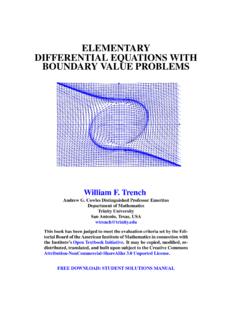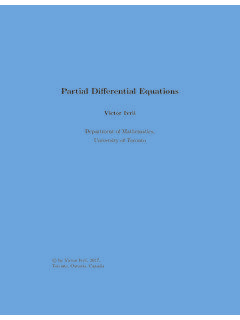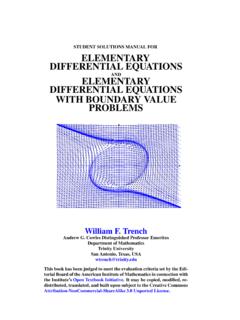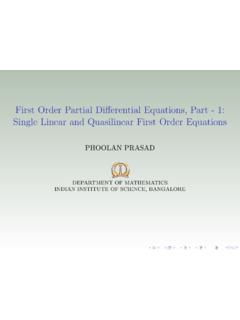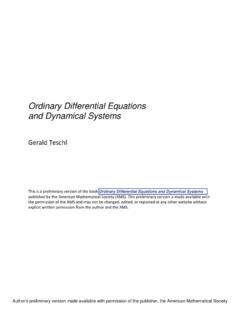Transcription of Second Order Differential Equations
1 Second OrderDifferential Equations this Section we start to learn how to solve Second Order Differential Equations of a particular type:those that are linear and have constant coefficients. Such Equations are used widely in the modellingof physical phenomena, for example, in the analysis of vibrating systems and the analysis of solution of these Equations is achieved in stages. The first stage is to find what is called a com-plementary function . The Second stage is to find a particular integral . Finally, the complementaryfunction and the particular integral are combined to form the general solution.
2 PrerequisitesBefore starting this Section you should.. understand what is meant by a differentialequation understand complex numbers (10)'&$%Learning OutcomesOn completion you should be able to.. recognise a linear , constant coefficientequation understand what is meant by the terms auxiliary equation and complementaryfunction find the complementary function when theauxiliary equation has real, equal or complexroots30 HELM (2008):Workbook 19: Differential Equations 1. Constant coefficient Second Order linear ODEsWe now proceed to study those Second Order linear Equations which have constant coefficients.
3 Thegeneral form of such an equation is:ad2ydx2+bdydx+cy=f(x)(3)wherea, b, care constants. Thehomogeneousform of (3) is the case whenf(x) 0:ad2ydx2+bdydx+cy= 0(4)To find the general solution of (3), it is first necessary to solve (4). The general solution of (4) iscalled thecomplementary functionand will always contain two arbitrary constants. We will denotethis solution technique for finding the complementary function is described in this which of the following are constant coefficient which are homogeneous.(a)d2ydx2+ 4dydx+ 3y=e 2x(b)xd2ydx2+ 2y= 0(c)d2xdt2+ 3dxdt+ 7x= 0(d)d2ydx2+ 4dydx+ 4y= 0 Your solution(a)(b)(c)(d)Answer(a) is constant coefficient and is not homogeneous.
4 (b) is homogeneous but not constant coefficient as the coefficient ofd2ydx2isx, a variable.(c) is constant coefficient and homogeneous. In this example the dependent variable isx.(d) is constant coefficient and : A complementary function is the general solution of a homogeneous, linear Differential (2008):Section : Second Order Differential Equations312. Finding the complementary functionTo find the complementary function we must make use of the following (x)andy2(x)are any two (linearly independent) solutions of a linear , homogeneous Second orderdifferential equation then the general solutionycf(x),isycf(x) =Ay1(x) +By2(x)whereA, Bare see that the Second Order linear ordinary Differential equation has two arbitrary constants in itsgeneral solution.
5 The functionsy1(x)andy2(x)arelinearly independentif one is not a multipleof the 5 Verify thaty1=e4xandy2=e2xboth satisfy the constant coefficient linearhomogeneous equation:d2ydx2 6dydx+ 8y= 0 Write down the general solution of this , differentiation yields:dy1dx= 4e4xandd2y1dx2= 16e4xSubstitution into the left-hand side of the ODE gives16e4x 6(4e4x) + 8e4x, which equals 0, sothaty1=e4xis indeed a ify2=e2x,thendy2dx= 2e2xandd2y2dx2= into the left-hand side of the ODE gives4e2x 6(2e2x) + 8e2x, which equals 0, so thaty2=e2xis also a solution of equation the ODE. Now e2xand e4xare linearly independent functions,so, from the property stated above we have:ycf(x) =Ae4x+Be2xis the general solution of the (2008):Workbook 19: Differential Equations Example 6 Find values ofkso thaty=ekxis a solution of:d2ydx2 dydx 6y= 0 Hence state the general suggested we try a solution of the formy=ekx.
6 Differentiating we finddydx=kekxandd2ydx2= into the given equation yields:k2ekx kekx 6ekx= 0that is(k2 k 6)ekx= 0 The only way this equation can be satisfied for all values ofxis ifk2 k 6 = 0that is,(k 3)(k+ 2) = 0so thatk= 3ork= 2. That is to say, ify=ekxis to be a solutionof the Differential equation,kmust be either 3 or 2. We therefore have found two solutions:y1(x) =e3xandy2(x) =e 2xThese are linearly independent and therefore the general solution isycf(x) =Ae3x+Be 2xThe equationk2 k 6 = 0for determiningkis called theauxiliary substitutingy=ekx, find values ofkso thatyis a solution ofd2ydx2 3dydx+ 2y= 0 Hence, write down two solutions, and the general solution of this find the auxiliary equation:Your solutionAnswerk2 3k+ 2 = 0 HELM (2008):Section : Second Order Differential Equations33 Now solve the auxiliary equation and write down the general solution.
7 Your solutionAnswerThe auxiliary equation can be factorised as(k 1)(k 2) = 0and so the required values ofkare1 and 2. The two solutions arey=exandy=e2x. The general solution isycf(x) =Aex+Be2xExample 7 Find the auxiliary equation of the Differential equation:ad2ydx2+bdydx+cy= 0 SolutionWe try a solution of the formy=ekxso thatdydx=kekxandd2ydx2= into the given Differential equation yields:ak2ekx+bkekx+cekx= 0that is(ak2+bk+c)ekx= 0 Since this equation is to be satisfied for all values ofx, thenak2+bk+c= 0is the required auxiliary Point 5 Theauxiliary equationofad2ydx2+bdydx+cy= 0isak2+bk+c= 0wherey=ekx34 HELM (2008):Workbook 19: Differential Equations TaskWrite down, but do not solve, the auxiliary Equations of the following.
8 (a)d2ydx2+dydx+y= 0,(b)2d2ydx2+ 7dydx 3y= 0(c)4d2ydx2+ 7y= 0,(d)d2ydx2+dydx= 0 Your solution(a)(b)(c)(d)Answer(a)k2+k+ 1 = 0(b)2k2+ 7k 3 = 0(c)4k2+ 7 = 0(d)k2+k= 0 Solving the auxiliary equation gives the values ofkwhich we need to find the complementary the nature of the roots will depend upon the values ofa, 1 Ifb2>4acthe roots will be real and distinct. The two values ofkthus obtained,k1andk2, will allow us to write down two independent solutions:y1(x) =ek1xandy2(x) =ek2x,and sothe general solution of the Differential equation will be:y(x) =Aek1x+Bek2xKey Point 6If the auxiliary equation has real, distinct rootsk1andk2, thecomplementary functionwill be:ycf(x) =Aek1x+Bek2xCase 2On the other hand, ifb2= 4acthe two roots of the auxiliary equation will be equal and thismethod will therefore only yield one independent solution.
9 In this case, special treatment is 3 Ifb2<4acthe two roots of the auxiliary equation will be complex, that is,k1andk2will be complex numbers. The procedure for dealing with such cases will become apparent in thefollowing (2008):Section : Second Order Differential Equations35 Example 8 Find the general solution of:d2ydx2+ 3dydx 10y= 0 SolutionBy lettingy=ekx, so thatdydx=kekxandd2ydx2=k2ekxthe auxiliary equation is found to be:k2+ 3k 10 = 0and so(k 2)(k+ 5) = 0so thatk= 2andk= 5. Thus there exist two solutions:y1=e2xandy2=e can write the general solution as:y=Ae2x+Be 5xExample 9 Find the general solution of:d2ydx2+ 4y= 0 SolutionAs before, lety=ekxso thatdydx=kekxandd2ydx2= auxiliary equation is easily found to be:k2+ 4 = 0that is,k2= 4so thatk= 2i, that is,we have complex roots.
10 The two independent solutions of the equation are thusy1(x) =e2ixy2(x) =e 2ixso that the general solution can be written in the formy(x) =Ae2ix+Be , in cases such as this, it is usual to rewrite the solution in the following that Euler s relations give: e2ix= cos 2x+isin 2xand e 2ix= cos 2x isin 2xso thaty(x) =A(cos 2x+isin 2x) +B(cos 2x isin 2x).If we now relabel the constants such thatA+B=CandAi Bi=Dwe can write the generalsolution in the form:y(x) =Ccos 2x+Dsin 2xNote: In Example 8 we have expressed the solution asy=..whereas in Example 9 we haveexpressed it asy(x) =.. Either will (2008):Workbook 19: Differential Equations Example 10 Givenay +by +cy= 0,write down the auxiliary equation.
